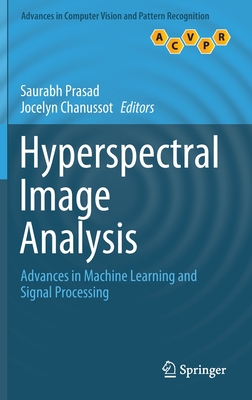Image Understanding using Sparse Representations (Paperback)
暫譯: 稀疏表示的影像理解 (平裝本)
Jayaraman J. Thiagarajan, Karthikeyan Natesan Ramamurthy, Pavan Turaga, Andreas Spanias
- 出版商: Morgan & Claypool
- 出版日期: 2014-04-01
- 售價: $1,530
- 貴賓價: 9.5 折 $1,454
- 語言: 英文
- 頁數: 118
- 裝訂: Paperback
- ISBN: 162705359X
- ISBN-13: 9781627053594
-
相關分類:
影像辨識 Image-recognition
海外代購書籍(需單獨結帳)
買這商品的人也買了...
-
 High-Performance Computing: Paradigm and Infrastructure (Hardcover) (廠商庫存書側有些許黴斑,若不介意再下單)
High-Performance Computing: Paradigm and Infrastructure (Hardcover) (廠商庫存書側有些許黴斑,若不介意再下單)$1,560$1,529 -
 $500深入淺出密碼學-常用加密技術原理與應用 (Understanding Cryptography: A Textbook for Students and Practitioners)
$500深入淺出密碼學-常用加密技術原理與應用 (Understanding Cryptography: A Textbook for Students and Practitioners) -
 Theory of Conditional Games (Paperback)
Theory of Conditional Games (Paperback)$2,620$2,489 -
 高等微積分【解析概論】
高等微積分【解析概論】$550$523 -
 Deep Learning|用 Python 進行深度學習的基礎理論實作
Deep Learning|用 Python 進行深度學習的基礎理論實作$580$458 -
 OpenCV 3 學習手冊 (Learning OpenCV 3: Computer Vision in C++ with the OpenCV Library)
OpenCV 3 學習手冊 (Learning OpenCV 3: Computer Vision in C++ with the OpenCV Library)$1,200$948 -
 Digital Design: With an Introduction to the Verilog HDL, VHDL, and SystemVerilog, 6/e (GE-Paperback)
Digital Design: With an Introduction to the Verilog HDL, VHDL, and SystemVerilog, 6/e (GE-Paperback)$1,380$1,352 -
 $465統計學習方法, 2/e
$465統計學習方法, 2/e -
 機器學習的數學基礎 : AI、深度學習打底必讀
機器學習的數學基礎 : AI、深度學習打底必讀$580$458 -
 線性代數應該這樣學, 3/e
線性代數應該這樣學, 3/e$419$398 -
 $210深度神經網絡 FPGA 設計與實現
$210深度神經網絡 FPGA 設計與實現 -
 $454博弈論:策略分析入門, 3/e (Game Theory: A Nontechnical Introduction to the Analysis of Strategy, 3/e)
$454博弈論:策略分析入門, 3/e (Game Theory: A Nontechnical Introduction to the Analysis of Strategy, 3/e) -
 $458BERT 基礎教程:Transformer 大模型實戰
$458BERT 基礎教程:Transformer 大模型實戰 -
 線性代數(原書第10版)
線性代數(原書第10版)$594$564 -
 $449基於 GPT-3、ChatGPT、GPT-4 等 Transformer 架構的自然語言處理
$449基於 GPT-3、ChatGPT、GPT-4 等 Transformer 架構的自然語言處理 -
 跟 NVIDIA 學深度學習!從基本神經網路到 ......、GPT、BERT...,紮穩機器視覺與大型語言模型 (LLM) 的建模基礎
跟 NVIDIA 學深度學習!從基本神經網路到 ......、GPT、BERT...,紮穩機器視覺與大型語言模型 (LLM) 的建模基礎$880$748 -
 算力芯片 — 高性能 CPU / GPU / NPU 微架構分析
算力芯片 — 高性能 CPU / GPU / NPU 微架構分析$774$735
相關主題
商品描述
Image understanding has been playing an increasingly crucial role in several inverse problems and computer vision. Sparse models form an important component in image understanding, since they emulate the activity of neural receptors in the primary visual cortex of the human brain. Sparse methods have been utilized in several learning problems because of their ability to provide parsimonious, interpretable, and efficient models. Exploiting the sparsity of natural signals has led to advances in several application areas including image compression, denoising, inpainting, compressed sensing, blind source separation, super-resolution, and classification.
The primary goal of this book is to present the theory and algorithmic considerations in using sparse models for image understanding and computer vision applications. To this end, algorithms for obtaining sparse representations and their performance guarantees are discussed in the initial chapters. Furthermore, approaches for designing overcomplete, data-adapted dictionaries to model natural images are described. The development of theory behind dictionary learning involves exploring its connection to unsupervised clustering and analyzing its generalization characteristics using principles from statistical learning theory. An exciting application area that has benefited extensively from the theory of sparse representations is compressed sensing of image and video data. Theory and algorithms pertinent to measurement design, recovery, and model-based compressed sensing are presented. The paradigm of sparse models, when suitably integrated with powerful machine learning frameworks, can lead to advances in computer vision applications such as object recognition, clustering, segmentation, and activity recognition. Frameworks that enhance the performance of sparse models in such applications by imposing constraints based on the prior discriminatory information and the underlying geometrical structure, and kernelizing the sparse coding and dictionary learning methods are presented. In addition to presenting theoretical fundamentals in sparse learning, this book provides a platform for interested readers to explore the vastly growing application domains of sparse representations.
Table of Contents: Introduction / Sparse Representations / Dictionary Learning: Theory and Algorithms / Compressed Sensing / Sparse Models in Recognition / Bibliography / Authors' Biographies
商品描述(中文翻譯)
影像理解在多個反向問題和計算機視覺中扮演著越來越重要的角色。稀疏模型是影像理解中的一個重要組成部分,因為它們模擬了人腦初級視覺皮層中神經感受器的活動。由於稀疏方法能夠提供簡約、可解釋且高效的模型,因此在多個學習問題中得到了應用。利用自然信號的稀疏性已經在多個應用領域取得了進展,包括影像壓縮、去噪、修補、壓縮感知、盲源分離、超解析度和分類。
本書的主要目標是介紹使用稀疏模型進行影像理解和計算機視覺應用的理論和算法考量。為此,初始章節中討論了獲取稀疏表示的算法及其性能保證。此外,還描述了設計過完備、數據自適應字典以建模自然影像的方法。字典學習背後的理論發展涉及探索其與無監督聚類的關聯,並利用統計學習理論的原則分析其泛化特性。一個從稀疏表示理論中受益匪淺的令人興奮的應用領域是影像和視頻數據的壓縮感知。與測量設計、恢復和基於模型的壓縮感知相關的理論和算法將被介紹。當稀疏模型與強大的機器學習框架適當整合時,可以在計算機視覺應用中取得進展,例如物體識別、聚類、分割和活動識別。這些框架通過基於先前的區分信息和潛在的幾何結構施加約束,並對稀疏編碼和字典學習方法進行核化,從而增強稀疏模型在這些應用中的性能。除了介紹稀疏學習的理論基礎外,本書還為有興趣的讀者提供了一個探索稀疏表示日益增長的應用領域的平台。
目錄:介紹 / 稀疏表示 / 字典學習:理論與算法 / 壓縮感知 / 稀疏模型在識別中的應用 / 參考文獻 / 作者簡介











